Investigation of Flame Evolution in Heavy Oil Boiler Bench Using High-Speed Planar Laser-Induced Fluorescence Imaging
Abstract
:1. Introduction
2. Experiment Details
3. Results and Discussion
3.1. Forced Ignition Process
3.2. Autoignition Process
3.3. Spatial Distribution of Flame
4. Conclusions
Author Contributions
Funding
Acknowledgments
Conflicts of Interest
References
- Hanson, R.K.; Seitzman, J.M.; Paul, P.H. Planar laser-fluorescence imaging of combustion gases. Appl. Phys. B 1990, 50, 441–454. [Google Scholar] [CrossRef]
- Giezendanner, R.; Keck, O.; Weigan, P. Periodic combustion instabilities in a swirl burner studied by phase-locked planar laser-induced fluorescence. Combus. Sci. Technol. 2003, 175, 721–741. [Google Scholar] [CrossRef]
- Kaminski, C.F.; Hult, J.; Alden, M. High repetition rate planar laser induced fluorescence of OH in a turbulent non-premixed flame. Appl. Phys. B 1999, 68, 757–760. [Google Scholar] [CrossRef]
- Cho, Y.; Kim, J.H.; Cho, T. Analysis of turbulent premixed flame structure using simultaneous PIV-OH PLIF. J. Vis. 2004, 7, 43–54. [Google Scholar] [CrossRef]
- Versluis, M.; Georgiev, N.; Martinsson, L. 2-D absolute OH concentration profiles in atmospheric flames using planar LIF in a bi-directional laser beam configuration. Appl. Phys. B 1997, 65, 411–417. [Google Scholar] [CrossRef]
- Bruchhausen, M.; Guillard, F.; Lemoine, F. Instantaneous measurement of two-dimensional temperature distributions by means of two-color planar laser induced fluorescence (PLIF). Exp. Fluids 2005, 38, 123–131. [Google Scholar] [CrossRef]
- Frank, J.H.; Kalt, A.M.; Bilgera, R.W. Measurements of conditional velocities in turbulent premixed flames by simultaneous OH PLIF and PIV. Combust. Flame 1999, 116, 220–232. [Google Scholar] [CrossRef]
- Giezendanner-Thoben, R.; Meier, U.; Meier, W. Phase-locked temperature measurements by two-line OH PLIF thermometry of a self-excited combustion instability in a gas turbine model combustor. Flow Turbul. Combus. 2005, 75, 317–333. [Google Scholar] [CrossRef]
- Kiefer, J.; Li, Z.S.; Zetterberg, J. Investigation of local flame structures and statistics in partially premixed turbulent jet flames using simultaneous single-shot CH and OH planar laser-induced fluorescence imaging. Combust. Flame 2008, 154, 802–818. [Google Scholar] [CrossRef]
- Li, Z.S.; Li, B.; Sun, Z.W. Turbulence and combustion interaction: High resolution local flame front structure visualization using simultaneous single-shot PLIF imaging of CH, OH, and CH2O in a piloted premixed jet flame. Combust. Flame 2010, 157, 1087–1096. [Google Scholar] [CrossRef]
- Fu, J.; Tang, C.L.; Jin, W. Study on laminar flame speed and flame structure of syngas with varied compositions using OH-PLIF and spectrograph. Int. J. Hydrogen Energy 2013, 38, 1636–1643. [Google Scholar] [CrossRef]
- Juddoo, M.; Masri, A.R. High-speed OH-PLIF imaging of extinction and re-ignition in non-premixed flames with various levels of oxygenation. Combust. Flame 2011, 158, 902–914. [Google Scholar] [CrossRef]
- Osborne, J.R.; Ramji, S.A.; Carter, C.D. Relationship between local reaction rate and flame structure in turbulent premixed flames from simultaneous 10 kHz TPIV, OH PLIF, and CH2O PLIF. Proc. Combust. Inst. 2017, 36, 1835–1841. [Google Scholar] [CrossRef]
- Lefebvre, A.H. Fuel Effects on gas turbine combustion-liner temperature, pattern factor, and pollutant emissions. J. Aircr. 1984, 21, 887–898. [Google Scholar] [CrossRef]
- Jaravel, T.; Riber, E.; Cuenot, B. Large Eddy. Simulation of an industrial gas turbine combustor using reduced chemistry with accurate pollutant prediction. Proc. Combust. Inst. 2017, 36, 3817–3825. [Google Scholar] [CrossRef]
- Seljeskog, M.; Sevault, A.; Ditaranto, M. Pursuing the oxy-fuel light-/heavy oil retrofit route in oil refineries—A small scale retrofit study. Energy Procedia 2013, 37, 7231–7248. [Google Scholar] [CrossRef]
- Wang, Z.Q.; Liu, M.; Cheng, X.X. Experimental study on oxy-fuel combustion of heavy oil. Int. J. Hydrogen Energy 2017, 42, 20306–20315. [Google Scholar] [CrossRef]
- Benedetto, A.D.; Cammarota, F.; Sarli, V.D. Reconsidering the flammability diagram for CH4/O2/N2, and CH4/O2/CO2 mixtures in light of combustion-induced rapid phase transition. Chem. Eng. Sci. 2012, 84, 142–147. [Google Scholar] [CrossRef]
- Jenny, P.; Roekaerts, D.; Beishuizen, N. Modeling of turbulent dilute spray combustion. Prog. Energy Combust. Sci. 2012, 38, 846–887. [Google Scholar] [CrossRef]
- Mercier, X.; Orain, M.; Grisch, F. Investigation of droplet combustion in strained counterflow diffusion flames using planar laser-induced fluorescence. Appl. Phys. B 2007, 88, 151–160. [Google Scholar] [CrossRef]
- Mastorakos, E. Ignition of turbulent non-premixed flames. Prog. Energy Combust. Sci. 2009, 35, 57–97. [Google Scholar] [CrossRef]
- Tay-Wo-Chong, L.; Zellhuber, M. Combined influence of strain and heat loss on turbulent premixed flame stabilization. Flow Turbul. Combust. 2016, 97, 263–294. [Google Scholar] [CrossRef]
- Sarli, V.D.; Benedetto, A.D. Sensitivity to the presence of the combustion submodel for large eddy simulation of transient premixed flame–vortex interactions. Ind. Eng. Chem. Res. 2012, 51, 7704–7712. [Google Scholar] [CrossRef]
- Shepherd, I.G.; Cheng, R.K. The burning rate of premixed flames in moderate and intense turbulence. Combust. Flame 2001, 127, 2066–2075. [Google Scholar] [CrossRef]
- Driscoll, J.F. Turbulent premixed combustion: Flamelet structure and its effect on turbulent burning velocities. Prog. Energy Combust. Sci. 2008, 34, 91–134. [Google Scholar] [CrossRef]
- Lawn, C.J.; Schefer, R.W. Scaling of premixed turbulent flames in the corrugated regime. Combust. Flame 2006, 146, 180–199. [Google Scholar] [CrossRef]
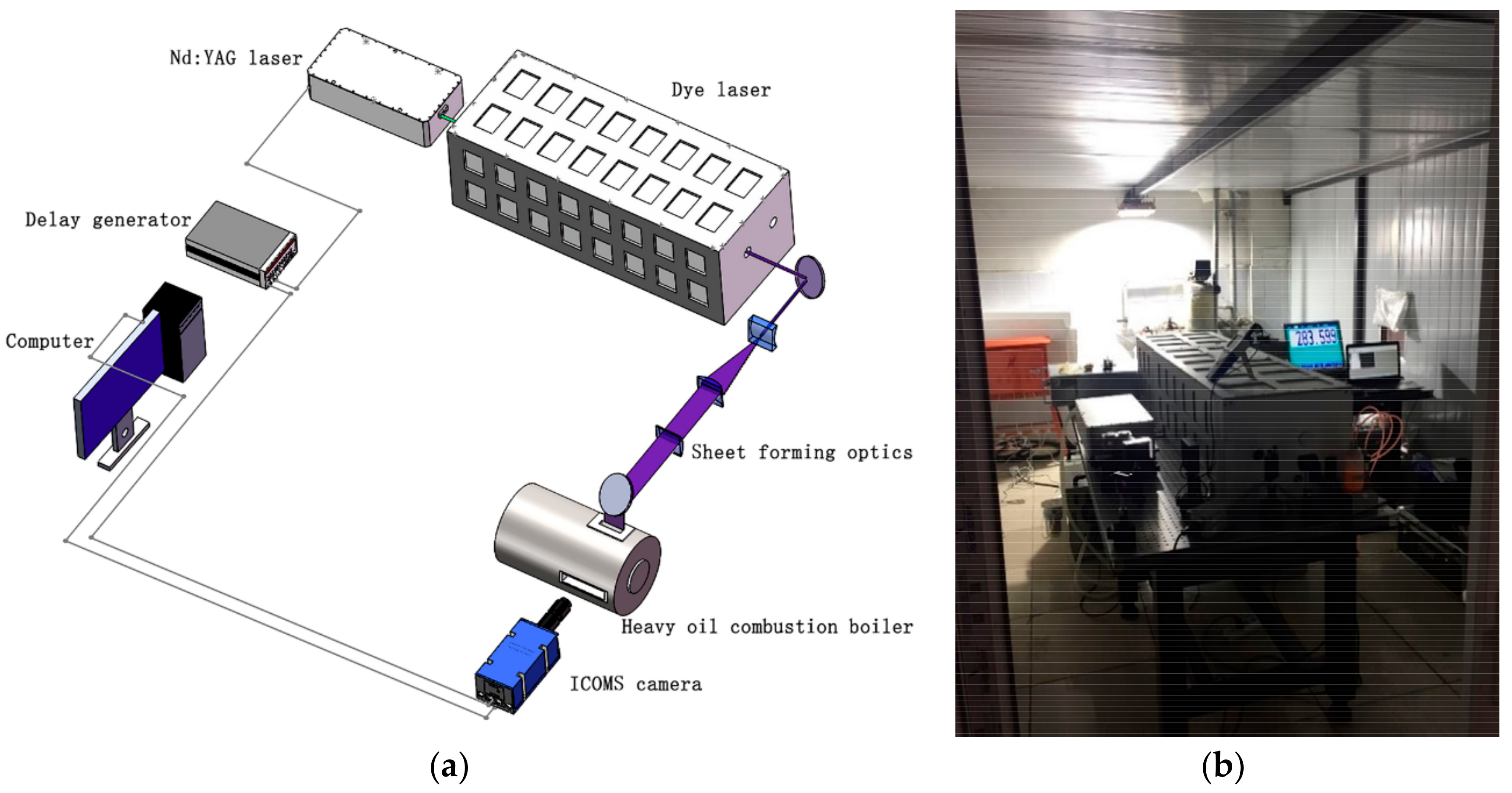
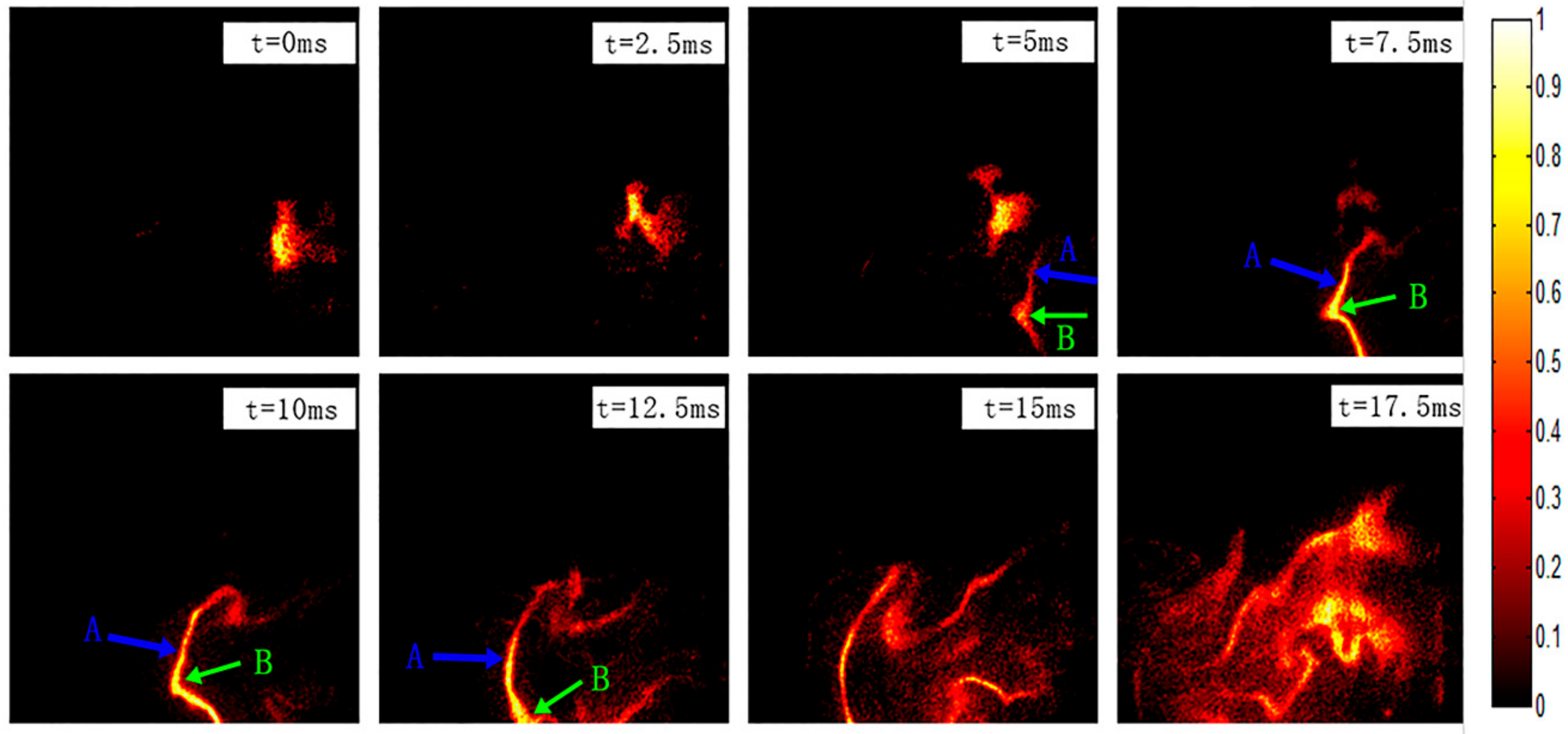
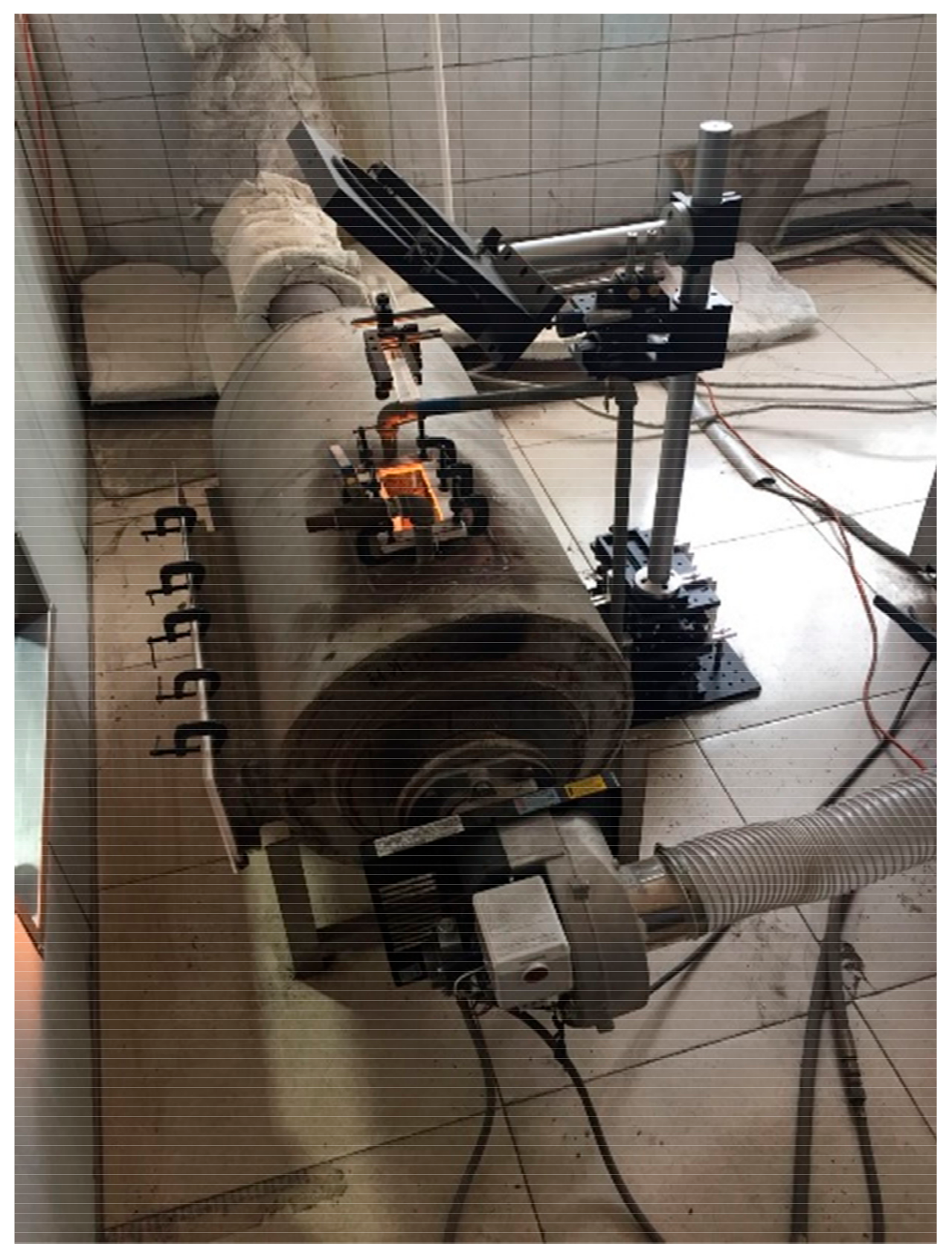
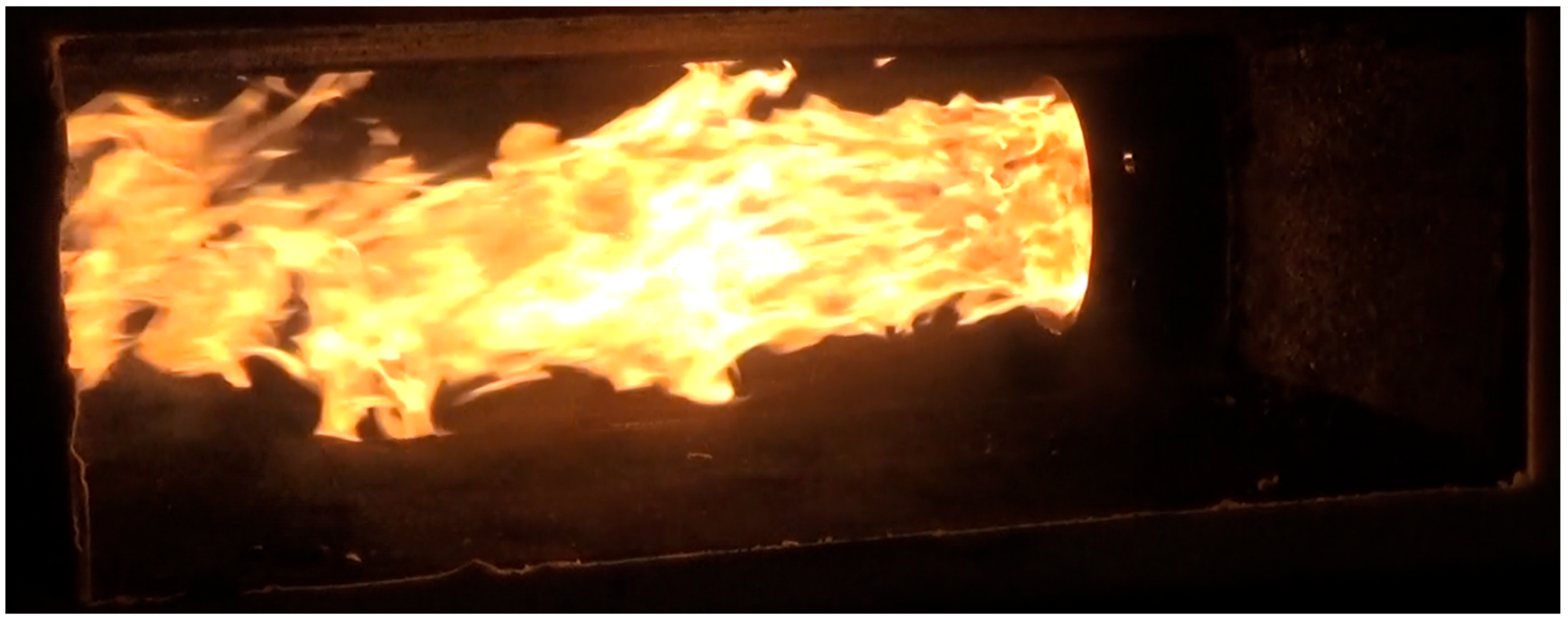
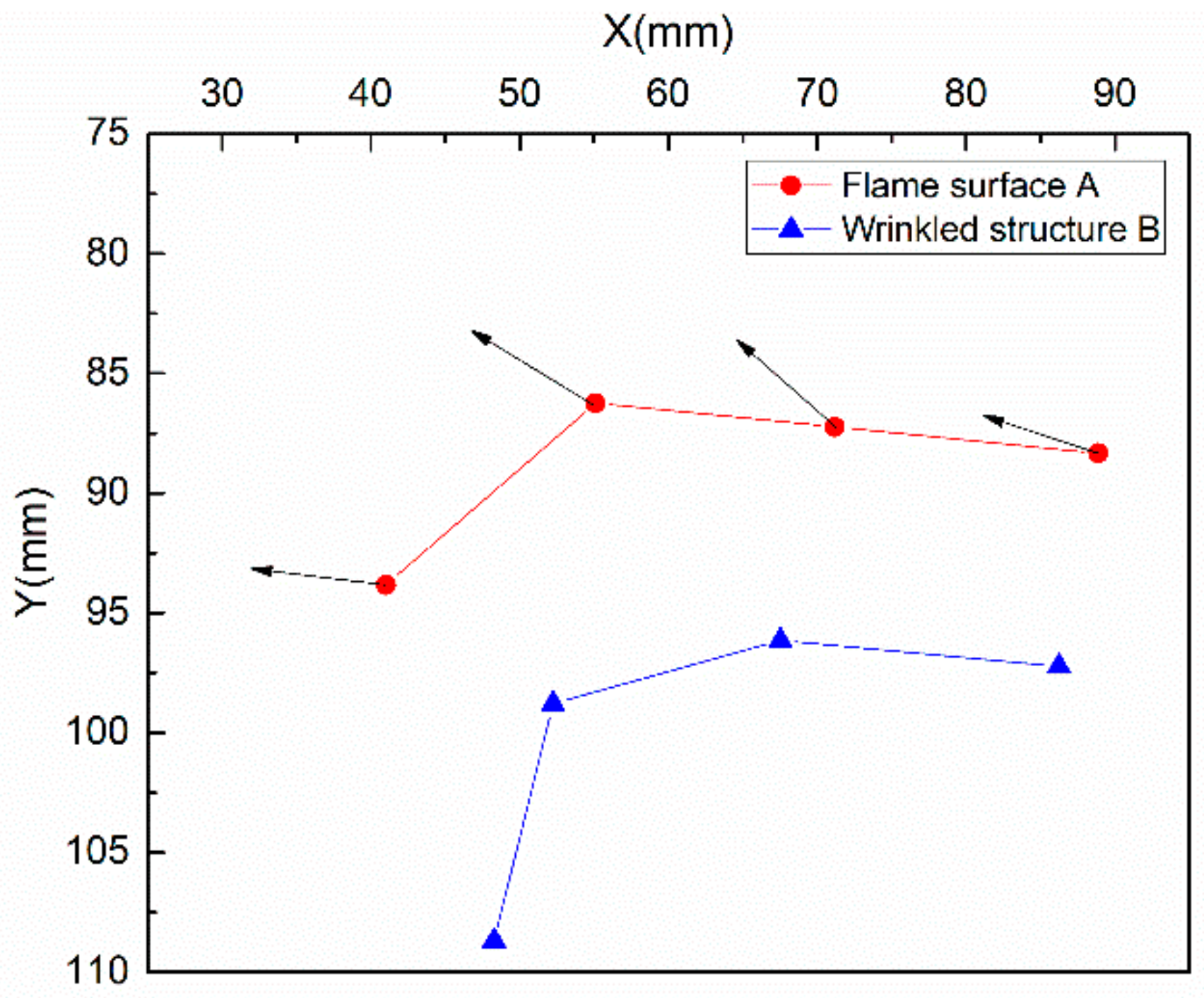
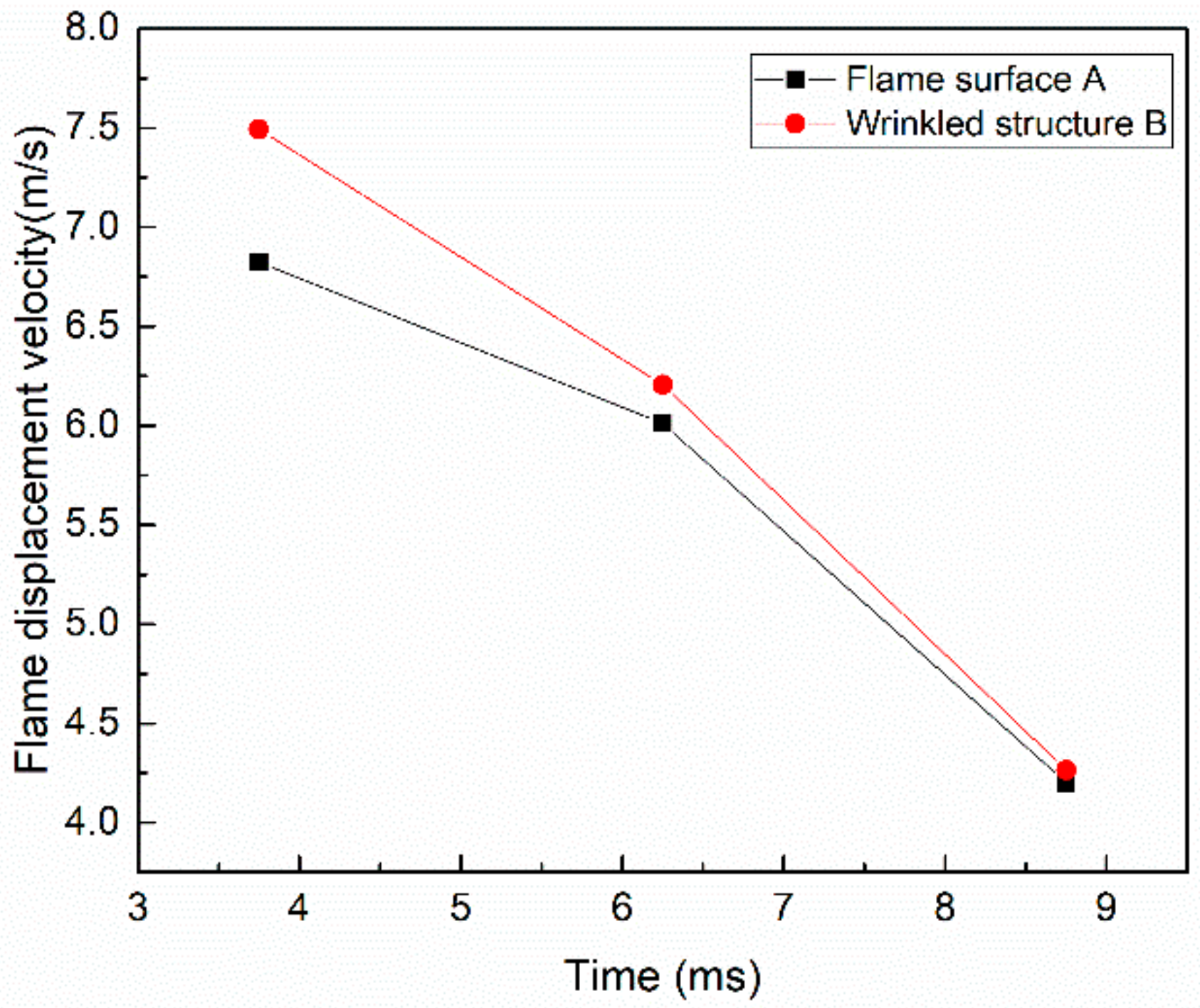
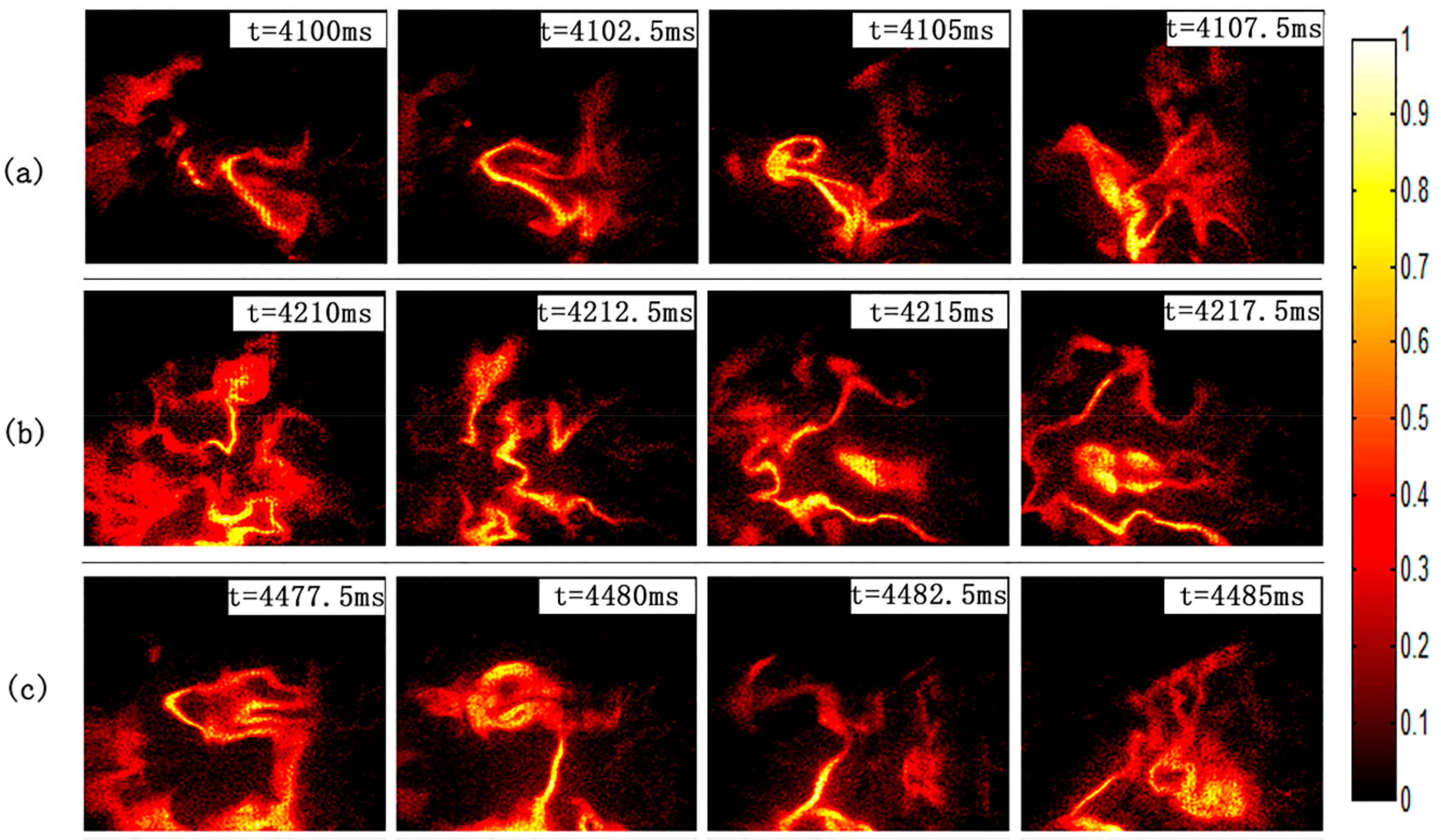
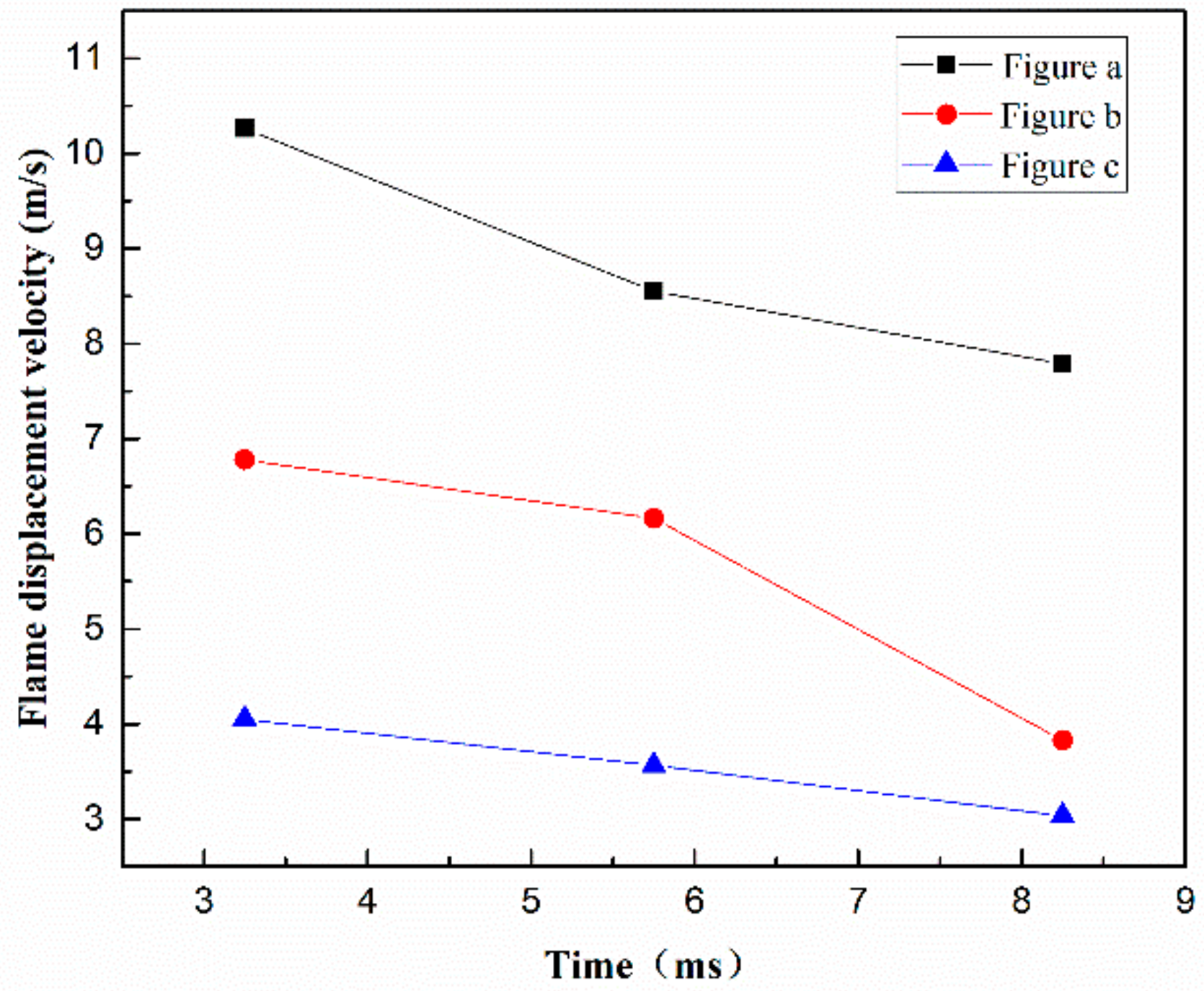

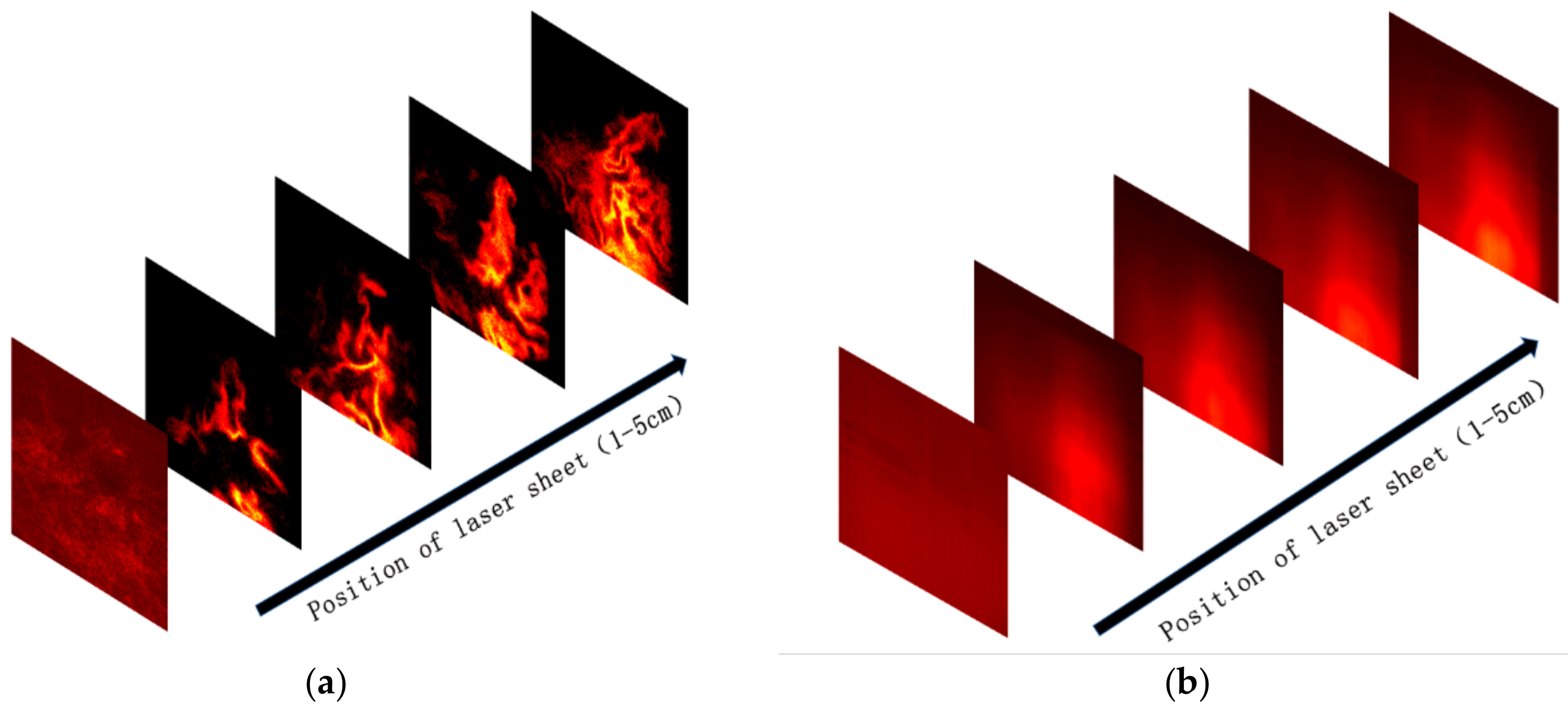
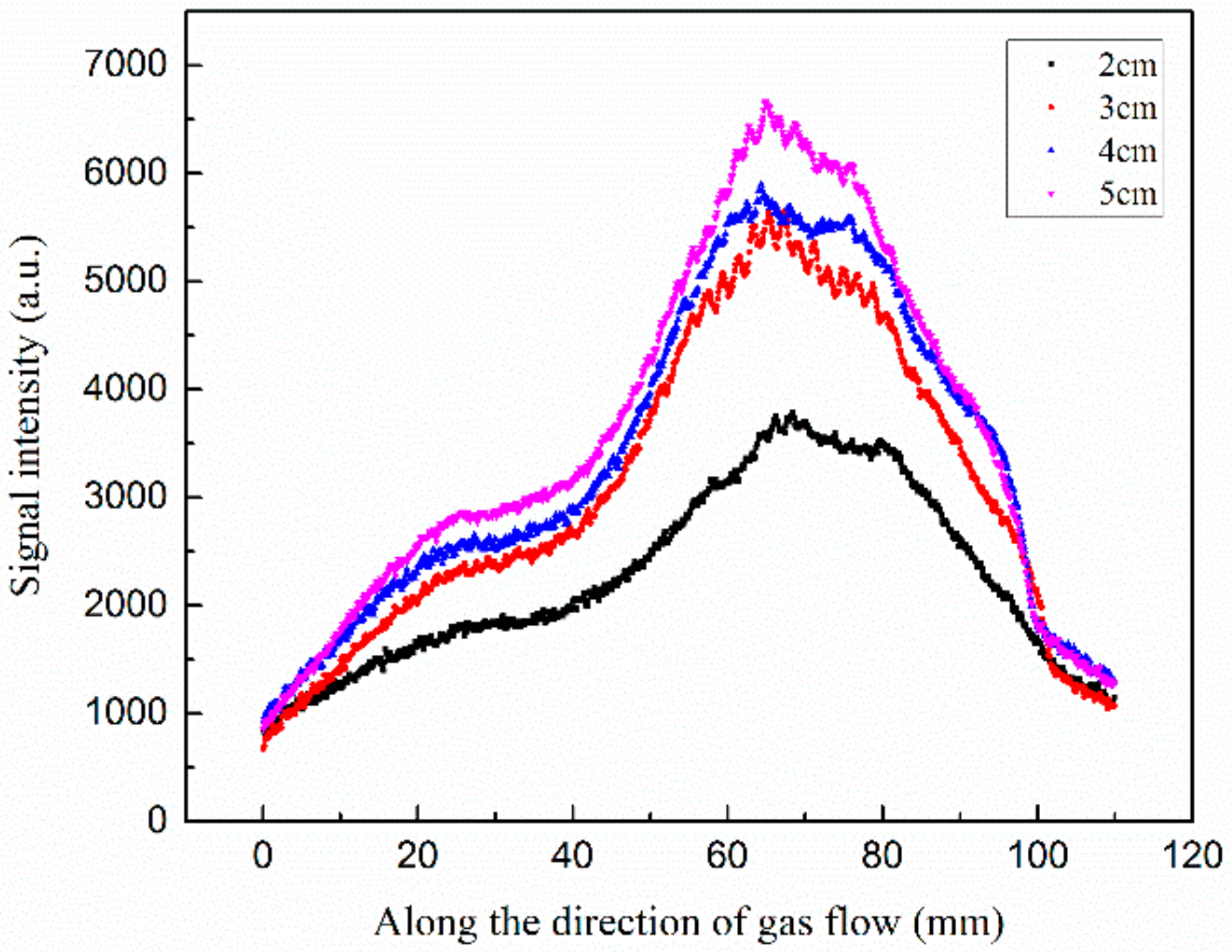
© 2018 by the authors. Licensee MDPI, Basel, Switzerland. This article is an open access article distributed under the terms and conditions of the Creative Commons Attribution (CC BY) license (http://creativecommons.org/licenses/by/4.0/).
Share and Cite
Peng, J.; Cao, Z.; Yu, X.; Yu, Y.; Chang, G.; Wang, Z. Investigation of Flame Evolution in Heavy Oil Boiler Bench Using High-Speed Planar Laser-Induced Fluorescence Imaging. Appl. Sci. 2018, 8, 1691. https://doi.org/10.3390/app8091691
Peng J, Cao Z, Yu X, Yu Y, Chang G, Wang Z. Investigation of Flame Evolution in Heavy Oil Boiler Bench Using High-Speed Planar Laser-Induced Fluorescence Imaging. Applied Sciences. 2018; 8(9):1691. https://doi.org/10.3390/app8091691
Chicago/Turabian StylePeng, Jiangbo, Zhen Cao, Xin Yu, Yang Yu, Guang Chang, and Zhiqiang Wang. 2018. "Investigation of Flame Evolution in Heavy Oil Boiler Bench Using High-Speed Planar Laser-Induced Fluorescence Imaging" Applied Sciences 8, no. 9: 1691. https://doi.org/10.3390/app8091691
APA StylePeng, J., Cao, Z., Yu, X., Yu, Y., Chang, G., & Wang, Z. (2018). Investigation of Flame Evolution in Heavy Oil Boiler Bench Using High-Speed Planar Laser-Induced Fluorescence Imaging. Applied Sciences, 8(9), 1691. https://doi.org/10.3390/app8091691



